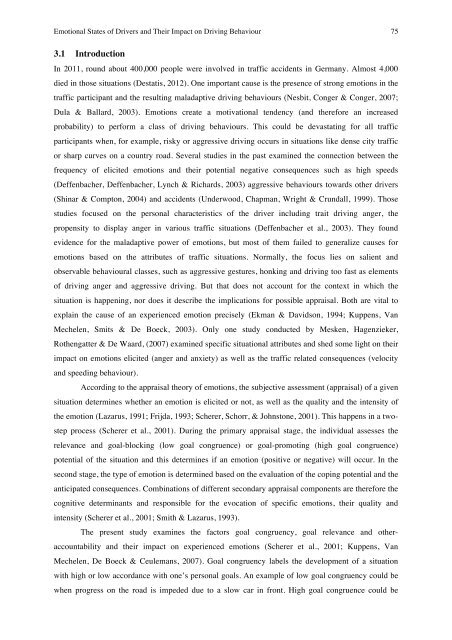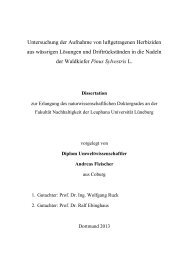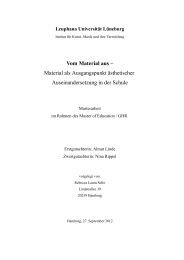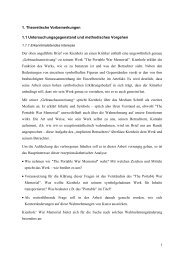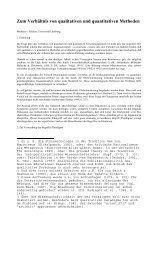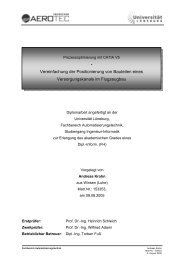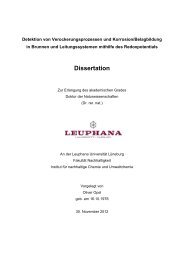Determinants of Emotional Experiences in Traffic Situations ... - OPUS
Determinants of Emotional Experiences in Traffic Situations ... - OPUS
Determinants of Emotional Experiences in Traffic Situations ... - OPUS
You also want an ePaper? Increase the reach of your titles
YUMPU automatically turns print PDFs into web optimized ePapers that Google loves.
<strong>Emotional</strong> States <strong>of</strong> Drivers and Their Impact on Driv<strong>in</strong>g Behaviour 75<br />
3.1 Introduction<br />
In 2011, round about 400,000 people were <strong>in</strong>volved <strong>in</strong> traffic accidents <strong>in</strong> Germany. Almost 4,000<br />
died <strong>in</strong> those situations (Destatis, 2012). One important cause is the presence <strong>of</strong> strong emotions <strong>in</strong> the<br />
traffic participant and the result<strong>in</strong>g maladaptive driv<strong>in</strong>g behaviours (Nesbit, Conger & Conger, 2007;<br />
Dula & Ballard, 2003). Emotions create a motivational tendency (and therefore an <strong>in</strong>creased<br />
probability) to perform a class <strong>of</strong> driv<strong>in</strong>g behaviours. This could be devastat<strong>in</strong>g for all traffic<br />
participants when, for example, risky or aggressive driv<strong>in</strong>g occurs <strong>in</strong> situations like dense city traffic<br />
or sharp curves on a country road. Several studies <strong>in</strong> the past exam<strong>in</strong>ed the connection between the<br />
frequency <strong>of</strong> elicited emotions and their potential negative consequences such as high speeds<br />
(Deffenbacher, Deffenbacher, Lynch & Richards, 2003) aggressive behaviours towards other drivers<br />
(Sh<strong>in</strong>ar & Compton, 2004) and accidents (Underwood, Chapman, Wright & Crundall, 1999). Those<br />
studies focused on the personal characteristics <strong>of</strong> the driver <strong>in</strong>clud<strong>in</strong>g trait driv<strong>in</strong>g anger, the<br />
propensity to display anger <strong>in</strong> various traffic situations (Deffenbacher et al., 2003). They found<br />
evidence for the maladaptive power <strong>of</strong> emotions, but most <strong>of</strong> them failed to generalize causes for<br />
emotions based on the attributes <strong>of</strong> traffic situations. Normally, the focus lies on salient and<br />
observable behavioural classes, such as aggressive gestures, honk<strong>in</strong>g and driv<strong>in</strong>g too fast as elements<br />
<strong>of</strong> driv<strong>in</strong>g anger and aggressive driv<strong>in</strong>g. But that does not account for the context <strong>in</strong> which the<br />
situation is happen<strong>in</strong>g, nor does it describe the implications for possible appraisal. Both are vital to<br />
expla<strong>in</strong> the cause <strong>of</strong> an experienced emotion precisely (Ekman & Davidson, 1994; Kuppens, Van<br />
Mechelen, Smits & De Boeck, 2003). Only one study conducted by Mesken, Hagenzieker,<br />
Rothengatter & De Waard, (2007) exam<strong>in</strong>ed specific situational attributes and shed some light on their<br />
impact on emotions elicited (anger and anxiety) as well as the traffic related consequences (velocity<br />
and speed<strong>in</strong>g behaviour).<br />
Accord<strong>in</strong>g to the appraisal theory <strong>of</strong> emotions, the subjective assessment (appraisal) <strong>of</strong> a given<br />
situation determ<strong>in</strong>es whether an emotion is elicited or not, as well as the quality and the <strong>in</strong>tensity <strong>of</strong><br />
the emotion (Lazarus, 1991; Frijda, 1993; Scherer, Schorr, & Johnstone, 2001). This happens <strong>in</strong> a twostep<br />
process (Scherer et al., 2001). Dur<strong>in</strong>g the primary appraisal stage, the <strong>in</strong>dividual assesses the<br />
relevance and goal-block<strong>in</strong>g (low goal congruence) or goal-promot<strong>in</strong>g (high goal congruence)<br />
potential <strong>of</strong> the situation and this determ<strong>in</strong>es if an emotion (positive or negative) will occur. In the<br />
second stage, the type <strong>of</strong> emotion is determ<strong>in</strong>ed based on the evaluation <strong>of</strong> the cop<strong>in</strong>g potential and the<br />
anticipated consequences. Comb<strong>in</strong>ations <strong>of</strong> different secondary appraisal components are therefore the<br />
cognitive determ<strong>in</strong>ants and responsible for the evocation <strong>of</strong> specific emotions, their quality and<br />
<strong>in</strong>tensity (Scherer et al., 2001; Smith & Lazarus, 1993).<br />
The present study exam<strong>in</strong>es the factors goal congruency, goal relevance and otheraccountability<br />
and their impact on experienced emotions (Scherer et al., 2001; Kuppens, Van<br />
Mechelen, De Boeck & Ceulemans, 2007). Goal congruency labels the development <strong>of</strong> a situation<br />
with high or low accordance with one’s personal goals. An example <strong>of</strong> low goal congruency could be<br />
when progress on the road is impeded due to a slow car <strong>in</strong> front. High goal congruence could be<br />
!


